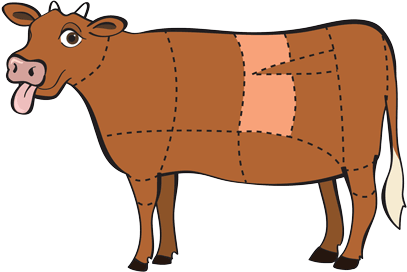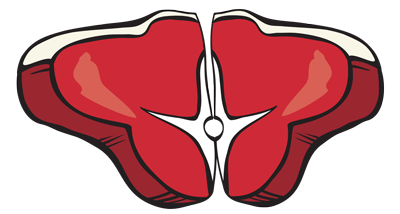Anatomy of a T-Bone

Universally recognized, the Beef T-Bone is considered one of the highest quality dinner table steaks. Its distinctive ‘T’ shaped bone is nestled between two steaks each themselves prized cuts of beef. This post explores the anatomy of the T-Bone to help you better understand and prepare this treasured cut.
Beef Primal

T-Bone is cut from the Short Loin primal of the animal pictured below. The distinctive ‘T’ shape comes from the lumbar vertebra being sawn in half through the vertebral column. The downward line of the ‘T’ is a transverse process of the vertebra. The small cutout semi-circle part missing from the top of the ‘T’ is half of the vertebral foramen. Putting it together as it would appear on the animal (looking head on) would appear something as follows:

Steaks of a T-Bone
There are two sides to each T-bone each containing a very different steak. The larger and meatier steak is the Strip Loin whereas the smaller steak is the Tenderloin. Each of these steaks are themselves prized in their own right for being quality dinner plate steaks.

To avoid any confusion both these steaks go by a number of different names depending on your country of origin:
Strip Loin – Sirloin (US), Strip Steak (US), New-York Strip (US), Striploin (UK), Porterhouse (AUS, NZ)
Tenderloin – Eye Fillet (AUS, NZ)
Tips
The following T-bone tips will help you choose and prepare a great steak every time:
- Choose a cut with a slight quantity of marbling, healthy-looking red color and white fat.
- Always take your steaks out of the refrigerator at least 30min before cooking.
- Season and lightly rub with olive oil before cooking, avoid salt however as it will draw the moisture out of the meat.
- Use a fast dry-heat method of cooking. A pre-heated skillet is perfect to cook to your desired level of doneness.
For further reading about preparing and cooking a T-Bone steak visit our T-Bone information sheet.


If you salt well ahead of time, it’s true that the salt will draw moisture out of the meat, but then the meat will reabsorb the salty liquid and become well-seasoned throughout the meat. Over time, this will make the meat more tender. Ideally, salt 24 hours in advance. At minimum, 45 minutes, which is how long it takes for the meat to reabsorb the liquid.
If you can’t salt at least 45 minutes ahead of time, then, yes, it’s best to salt right before cooking.
What about the steaks that are cooked inside a wall of salt? Those are supposed to be the best and juiciest?